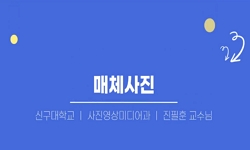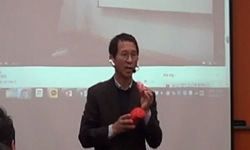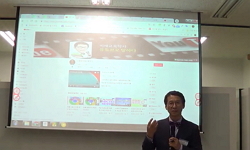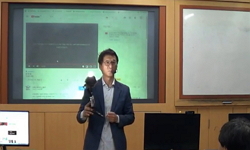1974년 <평면 오브제>를 시작으로 반세기에 걸쳐 오랜 작업을 이어온 김용익은 모더니즘의 반성적 비판을 삶으로 실천함으로써 예술과 삶을 일치시키는 개념미술을 수행해왔다. ‘논리...
http://chineseinput.net/에서 pinyin(병음)방식으로 중국어를 변환할 수 있습니다.
변환된 중국어를 복사하여 사용하시면 됩니다.
- 中文 을 입력하시려면 zhongwen을 입력하시고 space를누르시면됩니다.
- 北京 을 입력하시려면 beijing을 입력하시고 space를 누르시면 됩니다.

‘논리와 순리’: 김용익의 개념미술과 매체의 비은폐성 = ‘Rational Logic and Natural Order’: Kim Yong-Ik’s Conceptual Art and the ‘Unverborgenheit’ of the Medium
한글로보기https://www.riss.kr/link?id=A109126892
-
저자
정은영 (한국교원대학교)
- 발행기관
- 학술지명
- 권호사항
-
발행연도
2024
-
작성언어
Korean
-
주제어
Kim Yong-Ik ; Conceptual Art ; Un-concealment ; Medium ; Rational Logic and Natural Order ; Concealment and Revealing ; Korean Modernist Art ; Martin Heidegger ; 김용익 ; 개념미술 ; 비은폐성 ; 매체 ; 논리와 순리 ; 은폐와 개진 ; 한국의 모더니즘 ; 마르틴 하이데거
-
등재정보
KCI등재
-
자료형태
학술저널
- 발행기관 URL
-
수록면
7-36(30쪽)
- 제공처
-
0
상세조회 -
0
다운로드
부가정보
국문 초록 (Abstract)
1974년 <평면 오브제>를 시작으로 반세기에 걸쳐 오랜 작업을 이어온 김용익은 모더니즘의 반성적 비판을 삶으로 실천함으로써 예술과 삶을 일치시키는 개념미술을 수행해왔다. ‘논리와 순리의 일치’를 추구해 온 그의 개념미술에서 모더니즘 비판과 제도비판, 현실비판과 문명비판은 ‘감추기와 드러내기’가 공존하는 ‘비은폐적’ 매체를 통해 가시화된다. 본 연구는 김용익의 개념미술의 요체가 그의 반성적 비판을 역설적으로 드러내는 매체의 ‘비은폐성’에 있다고 보고, 그 형식적인 양상과 비판적인 함의를 밝히는 데에 목적을 둔다. 매체의 ‘비은폐성’은 철학자 마르틴 하이데거(Martin Heidegger)가 대지의 ‘은폐’와 세계의 ‘개진’을 동시에 품고 있는 예술작품에서 진리가 발현하는 방식을 설명하면서 썼던 용어인데, 실제로 김용익은 1970년대 중반에 자신의 천 작업이 지닌 회화적 평면과 물질적 오브제의 특성을 ‘은폐와 개진’의 개념을 들여와 탐구한 바 있다. 김용익의 개념미술에 나타나는 매체의 ‘비은폐적’ 양상을 분석하고 그 함의를 밝히기 위해 본 연구는 그의 작업을 크게 두 가지 차원으로 나누어 고찰하였다. 먼저 김용익의 저술을 중심으로 모더니즘 미술에 대한 논리적, 개념적 탐구가 제도비판에서 문명비판으로 확장되는 반성적 비판의 영역을 살펴보았고, 이어 그의 작품을 중심으로 천과 벽, 상자와 관, 글씨와 얼룩이 지니는 매체의 ‘비은폐적’ 양상을 분석하였다. 이를 통해 ‘논리와 순리’, ‘미학과 정치학’을 일치시키려는 김용익의 개념미술이 ‘감추기와 드러내기’가 역설적인 공존 속에서 삶과 예술의 물질적, 제도적, 존재론적 조건을 가시화하는 ‘비은폐적’ 작업임을 강조하였다.
다국어 초록 (Multilingual Abstract)
Kim Yong-Ik, whose artistic journey spans over half a century starting with his Plane Object in 1974, has practiced a reflective criticism of modernism in his conceptual art epitomized by the ‘coincidence of rational logic and natural order’. Kim ...
Kim Yong-Ik, whose artistic journey spans over half a century starting with his Plane Object in 1974, has practiced a reflective criticism of modernism in his conceptual art epitomized by the ‘coincidence of rational logic and natural order’. Kim has expanded his critical aesthetics towards art institutions, contemporary society, and modern civilization, through his ‘un-concealed’ mediums where ‘concealment and revealing’ coexist. Considering the ‘un-concealment’ of the medium as the quintessence of Kim’s conceptual art, this study aims to analyze the formal characteristics and critical implications of his ‘un-concealed’ mediums in lieu of his endeavor to integrate rational logic and natural order. The ‘un-concealment (Unvergorgenheit),’ according to Martin Heidegger, refers to the way in which truth manifests itself in a work of art; it simultaneously embodies the ‘self-concealment’ of the earth and the ‘revealing’ of the world. Notably, in the mid-1970s, Kim Yong-Ik embarked on an exploration of the paradoxical coexistence of ‘concealment and revealing,’ specifically in relation to the materiality of his painting, and it remained to play a critical role in his art. Through an in-depth examination of Kim’s writings and artworks, I illuminate how Kim’s conceptual art discloses the ontological conditions of art and life by his ‘un-concealed’ mediums.
동일학술지(권/호) 다른 논문
-
‘한국적 구상’으로서의 1960-70년대 반(半)추상 회화
- 미술사학연구회
- 조수진
- 2024
- KCI등재
-
〈아시안 고스트 스토리〉의 허구 전략: 대안적 역사 기술을 시도하는 허구 개입적 다큐멘터리
- 미술사학연구회
- 황윤정
- 2024
- KCI등재
-
대장정 프로젝트로 본 중국의 농민참여형미술 : 예술의 대중 수용에서부터 농촌 문제관여까지
- 미술사학연구회
- 강예민
- 2024
- KCI등재
-
평면에서 물성으로: 1970년대-1980년대 한국 추상회화의 평면 담론
- 미술사학연구회
- 홍지석
- 2024
- KCI등재




 KCI
KCI






